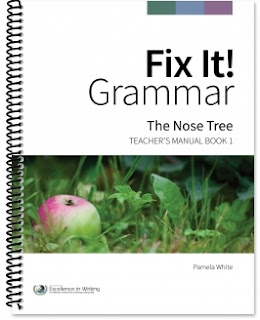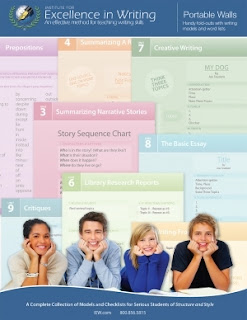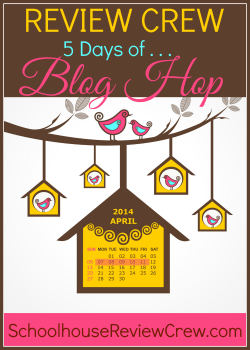Two years ago I hosted the class in my home and loved the new updated DVD presentations with a whole new generation of home educating families. Recently I.E.W. updated their video classes and blessed me with Deluxe Combo Teacher/Student Writing Package Level A [FIX-1 & 2].
Due to Asperger's Syndrome Nathaniel has been struggling in the area of language arts and especially composition. I recently discovered that Nathaniel learns best with short lessons, copy work and with clear instructions. Until now I had assumed that I need to wait till he was a lot older before beginning to use IEW with him due to his special needs. However after reading Does IEW Work with Special Needs Children? I couldn't wait to start with him and I am so pleased that I did. He is going from strength to strength. Writing is an arduous task for A.S.D. children and this was of particular concern for me. After a little bit of thought I decided that I need to be Nathaniel's scribe. This has worked very well for us and we have both been surprised at the results.
What we received
- Teaching Writing: Structure & Style DVD set
- Seminar Workbook
- Student Writing Intensive DVDs Level A, including the Structure & Style Overview
- Student Notebook with handouts and lesson plans
- Fix-It! Grammar, Book 1 [Teacher's Manual] with downloadable student e-book
- Fix-It! Grammar, Books 2 [Teacher's Manual] with downloadable student e-book
- A Word Write Now
- Portable Walls
How we used it
Teaching Writing Structure and Style Seminar and Practicum DVD and Practicum Workbook.
Receiving this new set was like having Christmas here. The new second edition of Teaching Writing Structure and style DVD set comes in a beautiful faux leather case containing a total of 12 DVD's.- History and Overview, Unit 1 and Unit 2
- Stylistic techniques, dress ups, modeling and practicum unit 1 & 2
- Unit 3 - Retelling Narrative Stories and Stylistic Techniques Sentence Openers
- Unit 4 - Summarizing a reference, topic clincher rule, decorations and tripple extensions
- Unit 5 - Writing from pictures
- Unit 6 - Using multiple references and advanced dress-ups
- Unit 7 - Inventive writing and Author Imitation
- Unit 8 - Formal Eassay, Basic, Expanded, Super and Persuasive, the TRIAC model
- Unit 9 - Fromal Critique, writing about literature, literature analysis
- Demonstration lessons Level A - Grades K-2 and Grades 3-5
- Demonstration Lessons Level B - Grades 6-8
- Demonstration Lesson Level C - Grades 9-12
I have been watching between half and one lesson a week depending on how much information is covered in a unit and how long the unit is.
The purpose of the seminar is to equip you to teach the IEW course materials to your children. Once you have completed the course you will be fully equipped to teach your children all the materials. You will not only learn how to write but you will gain a full understanding behind the why IEW choose to do certain things in a certain way. It gives you a clear picture of where you are heading with what you are doing. It enables you to make informed decisions when requiring certain tasks from your students.
When I first started homeschooling I wondered how I was going to teach my children composition and this was fairly easy for me to do ... Once I had completed the Writing Structure and Style I had a comprehensive knowledge of what writing really was and exactly what a well written composition actually looks like and how to evaluate work based on a measurable scale rather than something abstract.
I strongly encourage you to purchase a copy of the course because on top of learning how to teach your students to write well Andrew will teach you how to be a better teacher. Throughout the lessons he gives you practical advice on how to keep your students/children engaged and learning. He reminds you how to focus on what really is important so as not to sabotage your own effort and frustrate your children. Andrew helps you to really help your children become successful and thereby create a positive platform for everyone.
If you already own the first edition you are able to upgrade to the second edition for a nominal fee.
The workbook contains more than 200 pages and is a quality plastic three ring folder containing 12 cream pre-printed dividers covering each of the nine units and followed by three appendices.
I have a great collection of Seminar work books and have learned something new each time I have watched the seminar.
I love the new look and layout in the second edition of the IEW Teaching Writing Structure and Style workbook.
- There are samples supplied in every unit.
- Complete and detailed course notes
- Room for you to try each unit taught (applied practice so you the teacher understand what your students are going to be feeling when they do them for the first time)
- Checklists along with points for each requirement showing you how to grade your students work.
- Student samples for every unit. The samples are not random. There is a sample from primary, elementary, middle and high school for all the units. These samples are an excellent support helping you to grasp the level of work for all the age levels in your homeschool.
- Full lists of black-line masters available from IEW .
The purchase of this manual entitles you to copy the student related materials for use by multiple children within your immediate family.
Here is a look at the three manuals I have from IEW from the three times I have done this course. The original workbook contained 63 pages plus a teachers resource section. The new and updated folder from the 2015 edition contains over 200 pages plus resources. You can read more about the updates and differences between TWSS2000 AND TWSS2 levels on their website.
Student Writing Intensive Level A DVD's
This is a four disc program which comes in a hard cover plastic case.- Note Making and outlines (unit 1) and Writing from notes and intro to dress-ups (Unit 2)
- Story Summary (Unit 3) and Dress Ups
- Summarizing a reference (Unit 4) and Topic/Clincher
- Intentive writing Unit 7 #2 opener.
- Structure and Style overview DVD
For ASD children anything new can be a little overwhelming and can cause all sorts of anxiety reactions. To prepare Nathaniel for his IEW class I popped the first DVD on one day while he was building Lego and was pleasantly surprised to hear him giggle away through the class.
On the Monday when we began I decided to be the scribe and write for him. We sat together and watched the lesson. Pausing it many times to do each part as Andrew talked about it. Nathaniel has loved watching Andrew teach his classes and his humor is infectious. I caught him explaining to Paul that he is "not allowed to make the Dreaded Dad mistake..."
Due to his special needs we are taking a much slower pace in working our way through the lessons. Sometimes I stop the DVD after a five minute segment and we work on that aspect applying it to short stories each time we do composition. Our aim is not to complete the work in one year but to create well established skill sets before adding to them.
Here is a sample of the second story that Nathaniel dictated and I scribed. His assignment was to remove the word said, add in an 'ly' word and combine two sentences using the word which.
Jeffrey delightfully went into a candy store, reached into a bottle of candy. He grabbed a handful of candy which made his hand bulge and therefore he could not get his hand out. Jeffrey was unwilling to drop some candy. He burst into tears. The shop owner exclaimed "If you want to get your hand out you need to be satisfied with less candy. Sometimes you need to give up a little to get what you wish."We have both been surprised at what he has been able to accomplish in these past few weeks. I have especially enjoyed watching his confidence grow in leaps and bounds as he shows his stories to Paul, friends and family. A month ago he would not even attempt to compose a story now he is quite happy to apply himself and try as long as Mom is the scribe and writes it exactly as he dictates it.
Student Writing Intensive Notebook
This high quality folder is an excellent resource and helps your student to keep all of the course notes, resources papers, checklists and completed work together in one convenient location.It contains five tabbed dividers to help organize your work. The tabbed dividers are made of thicker card and can keep up with the required needs of being handled by students.
It also contains:
- A one page outline of how to set up your Notebook.
- Full scope and sequence - this includes a break down of which DVD, reinforcement lesson, required resources and optional resources.
- A page which contains a FULL DVD scene breakdown for the entire course making it easy to find the lesson you need to watch.
- A suggested course schedule to follow if you would like to complete it in a 30 week stretch doing it five days a week
- Each week contains a Teacher's Notes page where you will have a summary of the lesson and notes on which DVD to use and where to find the lesson on the DVD that is in relation to the notes for that specific week. On the back of the sheet is a sample of the weeks lesson including a sample of the possible outcome.
- Each story is supplied for the student to use.
- On the back of each story is a customized composition checklist containing the requirements for that specific lesson.
- Each of the lists needed are printed on different colour paper.
Fix It Grammar: Book 1 & 2
Language arts is not my strong suite even though I love to read, love to write and am fairly wordy in person, complex grammar remains shrouded in mystery. Over the years I have purchased many grammar curriculum's and they have remained mostly unused by me... My children have worked through the items on the shelf independently and I'm grateful they were able to decipher this important aspect of their educations on their own.HOWEVER I am very excited to tell you about Fix-It Grammar. This innovative program contains six books at present. The secret to it's success for me is the Teacher's Manual.
The beauty of Fix It Grammar is that it uses applied incidental grammar in it's approach. Each day the student is given ONE sentence from a classic story which contains intentional errors for the student to locate and fix. You can see something is wrong and fix it. Each day involves ten minutes of work and no prep work on my behalf.
The short one sentence approach suits Nathaniel very well and we are enjoying seeing the story take shape. Copying excellent literature and practicing grammar is helping Nathaniel learn quality in composition and by the time he has completed the work he will have written out a complete story.
The student book presents the whole weeks work on a two page uncluttered spread. On the left hand page there is a learn it section containing a short two minute grammar lesson. The next section contains the instructions for the weeks work. It gives a short description of what is expected of the student for each of the five days. The right hand page contains four days of sentences which are presented in double line spacing and easy for the student to read. The student does the work on the page each day. Once the corrections have been made and any missing punctuation inserted the sentence is then copied neatly into a separate copy book. We are looking forward to completing the book so that we can read the story in it's entirety.
The Teachers Manual is worth it's weight in gold to me. Each week of work is laid out over four pages.
- This page contains a summary of the week lesson ahead. This is similar to the student notebook.
- This page contains the first two days of work. First the sentence with it's 'fixes' in place. The next line explains the fixes and the third line for each day has grammar notations for that particular sentence. Advanced notations are included.
- This page is laid out in the same manor as the second page but covers day three and four.
- This page shows the four sentences as they should appear in your students work by the end of the week.
Book one contains 33 weeks of grammar work. At the back of the book you will find a full scope and sequence chart for the year of work.
The details
- ISBN: 978-1-62341-171-8
- Edition/Printing: Third Edition, January 2014
- Copyright Date: 2009, 2014
- Specifications: Teacher: 228 pages, Student e-book: 126 pages
- Fix It! Grammar Placement Tests
- By: Pamela White
- On YouTube: IEW: Fix It! Grammar
A Word Write Now
This is my favorite new resource from IEW. Years ago I aquared a thematic thesaurus when Timothy and Jane were working through the writing course. This thesaurus is an excellent companion to my original thesaurus and I highly recommend you add it to your bookshelf. The best part of this thesaurus is the way it helps you find words to help you build the character traits of the different character roles within your compositions. It has opened up a whole new world of describing the attitudes and emotions of people within the stories we are writing.For example if we are writing a fable about the tortoise and the lazy hare. Looking up the word lazy we discover that a lazy person is also known as a dawdler, dullard, laggard, plodder, sluggard and slacker. Lazy people are characterized by indolence, neglectfulness and lethargy. They are boring, idle, indifferent and inactive and find life to be tediously monotonous.
A Word Write Now is divided into four sections:
- Section A - Character Traits - when writing a story character plays an intricate roll in story formation. By organising a thesaurus by character traits it makes it easier for the student to use excellent descriptive words to communicate the character and emotion of their story.
- Section B - Descriptive Words
- Section C - Words for Movement and Senses
- Appendix - here you will find:
- Teaching ideas and tips on making words a fun part of every day.
- Words not related to time. Prepositions.
- Literary Genres.
- Definitions and examples of Literary Devices.
- A definition of the original word.
- A thought about the original word.
- Excerpts from Classical Literature. (helps to give contextual reference to the word)
- Words are classified by parts of speech (adjective, adverbs, verbs, etc).
- Space to add new words which are descriptive.
- A famous quote about the word.
The details
- ISBN: 978-1-62341-219-7
- Edition/Printing: Third Edition, August 2014
- Copyright Date: 2006, 2014
- Specifications: 112 pages
- Download a .PDF sample
- By: Loranna Schwacofer
- Illustrated by: Celina Barndt, Zechariah Romo & James Schwachofer. (Full colour)
- On YouTube: A Word Write Now: A Thematic Thesaurus for Stylized Writing
Portable Walls
When I first started using Excellence in Writing we made all sorts of wall charts (this was not very practical at home). When these did not work, I made lists which we laminated but there were always piles of laminated sheets everywhere and we were always getting muddled up.The portable wall chart correlates all the information in one place. It helps to create a word rich environment and is a 'living reference'. It is produced from firm card stock and is in a tri-fold shape and contains: 9 unit models/stylistic techniques, word lists, band word lists etc. Due to it's tri-fold shape it can stand up on the table in front of the student and is easily accessible. It's size also means that it is easy to store and handy. (YouTube: Portable Walls)
*Cost of Deluxe Combo Teacher/Student Writing Package Level A [FIX-1 & 2].
- $299 for the COMPLETE package
- Teaching Writing: Structure & Style DVD set - $189.00
- Seminar Workbook - $35.00
- Student Writing Intensive DVDs Level A, including the Structure & Style Overview - $109.00
- Student Notebook with handouts and lesson plans - $19.00
- Fix-It! Grammar, Books 1 and 2 with downloadable student e-books - $19.00
- A Word Write Now - $35.00
- Portable Walls - $7.00
** I.E.W. is available for purchase internationally. Find your nearest distributor here.
Recommended Age Range
- Grades 3 - 5
Connect with IEW
Over All
I am a long time IEW enthusiast and love the quality and versatility of their products. I feel this system is worth it's weight in gold and is something you will use for the entire life of your homeschooling years. It is my most recommended resource. Do not be overwhelmed by the volume of what is contained within this course. It is well laid out and it's step by step approach is foundational to it's success.
Blessings
Chareen










![Deluxe Combo Teacher/Student Writing Package Level A [FIX-1 & 2] Deluxe Combo Teacher/Student Writing Package Level A [FIX-1 & 2]](https://blogger.googleusercontent.com/img/b/R29vZ2xl/AVvXsEj3iYjOCW3-vsS-33s-TIfPSFjEIzWshoK-1tWwUBymS4ZzxTGXpVdqNr4z8Upu43zHtK3z6DtKKFdDjUJrOLpQ1lnm5lHVZBA9os0FrT9iXAY6iAQBAR7rO4DQVduwy82fesWtJwfdP_ex/s1600/Deluxe+Combo+B+Fix+1+and+2_zpskrg98fqq.jpg)






















